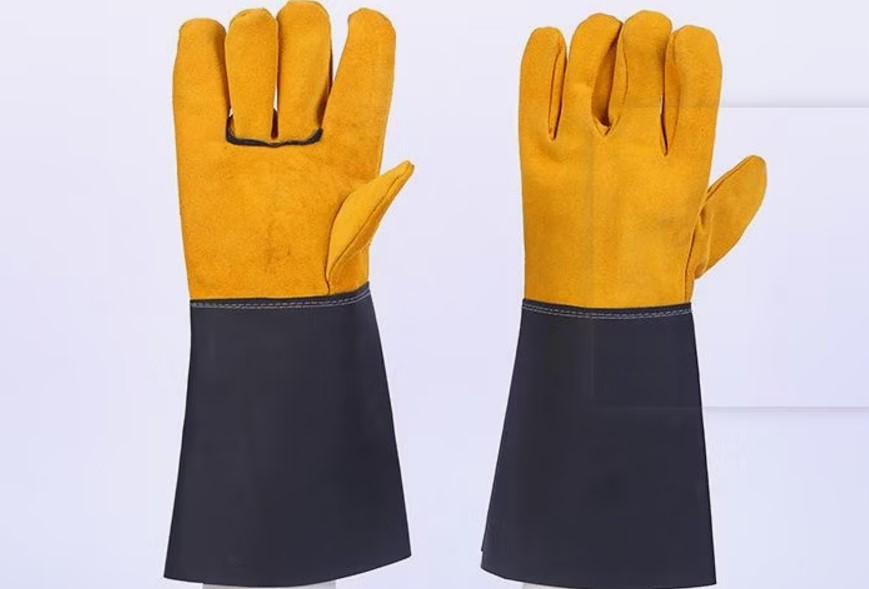The Savior of Handworkers: Welding Gloves and Their Crucial Role in Industrial Safety

Worker safety is paramount in heavy-duty industries, where sparks are commonplace, and extreme heat poses significant risks. Among the array of tools and equipment designed to safeguard these dedicated professionals, welding gloves emerge as a notable solution due to their effective blend of protection, durability, and comfort.
Welding gloves represent more than mere safety apparel; they are critical in construction, manufacturing, and automotive repair, where welding is a regular operation. These gloves are the main defense against hot temperatures, dangerous sparks, and molten metal. A fascinating story in industrial safety is the evolution of welding gloves from simple protective accessories to essential safety tools.
Welding Gloves: Not Just for Safety
Employees wear welding gloves to shield their hands and forearms from sparks, electrical shocks, physical abrasions, and the intense heat of welding.
However, their goal goes beyond simple functionality; it also involves maintaining the worker’s accuracy and competence. Welders’ hands must continue to be dexterous, capable of handling complex instruments and doing precise work. An overly thick or stiff glove can hamper performance. The ideal welding glove offers the best of both worlds by balancing flexibility and protection.

The Evolution of Welding Gloves: From Leather to High-Tech Materials
The history of welding gloves dates back to the early days of welding. Early welders, exposed to dangerous conditions with little to no protection, would use whatever they could find to shield their hands from molten metals. Early gloves were made from leather, an effective but limited material.
Although leather gloves were strong and provided some protection, they were frequently heavy and could not withstand heat well. As a result, the need for more advanced welding technology and protective gear grew. The invention of welding gloves was influenced by the 20th century’s development of heat-resistant materials.
Initially, aluminized fabric, flame-retardant synthetics, and Kevlar were used in glove designs. Modern welding gloves survive longer because they are made of materials that provide better heat and spark insulation. Depending on the type of welding, these cutting-edge gloves may be composed of carbon fiber, leather, cotton, or synthetic rubber.
For better maneuverability, MIG welding gloves, for instance, are frequently composed of supple, flexible leather. They were designed for welding using metal inert gas. Conversely, TIG (tungsten inert gas) welding gloves are often made of thin, high-quality leather for maximum agility. Stick welding gloves sometimes include Kevlar reinforcing to increase their protective properties because of the higher temperatures and electrical conductivity they must tolerate.
Welding gloves are necessary for worker safety and efficiency.
It is impossible to overstate how crucial welding gloves are to worker safety. National Safety Council (NSC) estimates that about 400,000 American workers are exposed to hazardous welding scenarios yearly. Without appropriate protection, the chance of getting hurt rises substantially. Proper gloves prevent burns, electrical shocks, cuts, and typical welding abrasions.
Protection from Burns: Welding gloves shield the hands and forearms from extreme heat. Workers could suffer severe burns from hot surfaces or molten metal without them.
Electrical Risks: Welders are susceptible to electrical shock, particularly when handling live wires or machinery. Proper welding gloves protect the hands from electric currents, lowering the chance of deadly shocks.
Improved Grip and Control: Welding gloves are made to offer improved grip in addition to safety. Welders frequently work in challenging environments where they must keep exact control over their tools. Reinforced palms and fingers of gloves increase grip, reducing the possibility of slipping while handling equipment.
Welding Gloves in Industrial Settings: The Data Speak for Us
Statistics support the necessity of welding gloves in industrial settings; it is not merely anecdotal. According to the Bureau of Labor Statistics (BLS), hand and finger injuries account for more than 30% of all welding-related injuries in the US. Welding gloves and other appropriate safety precautions can significantly decrease these injuries.
Furthermore, a study published by the Occupational Safety and Health Administration (OSHA) found that safety equipment, including gloves, can prevent up to 50% of the injuries caused by welding accidents. As industries strive for higher safety standards, welding gloves have become indispensable to the standard personal protective equipment (PPE) kit.
The New Features and Customization of the Modern Welding Glove
Modern welding gloves include many elements to improve comfort and performance. For instance, a lot of expensive gloves consist of:
Kevlar stitching: Even in the most severe circumstances, this adds resilience and keeps the gloves from tearing.
Ergonomic Design: Contemporary gloves are built to conform to the hand’s natural contours, improving flexibility and reducing tiredness throughout extended workdays.

Heat-Resistant Linings: Many gloves have lining materials that offer additional heat protection, enhancing comfort and avoiding burns.
Reinforced Areas: To guard against damage from repeated use, high-stress areas like the palm, thumb, and fingers frequently have additional reinforcement.
With increased worker safety awareness, many industries offer customizable welding gloves tailored to specific needs. Whether workers prefer a snug fit or extra wrist protection, the customization options ensure every worker gets the protection they deserve without sacrificing comfort.
Conclusion: Welding Gloves—A Worker’s Best Friend
Welding gloves represent industrial ingenuity and tenacity in addition to being a safety gear. These gloves have developed from their leather roots to offer the state-of-the-art protection and dexterity workers need to perform their jobs effectively and safely. With the development of materials and technology, welding gloves have emerged as a crucial part of personal protection equipment, ensuring that hardworking employees are protected and can give their best.
Given that thousands of welding professionals use welding gloves regularly worldwide, it is clear that they are more than just a product—they are a lifesaver. Welding gloves offer safety, comfort, and security in various industries, such as construction, auto repair, and metalworking. They save hardworking welders and others.
Biker, shiba-inu lover, guitarist, Swiss design-head and multidisciplinary designer. Performing at the fulcrum of aesthetics and programing to create not just a logo, but a feeling. Let’s design a world that’s thoughtful, considered and aesthetically pleasing.

